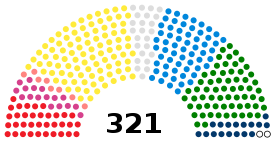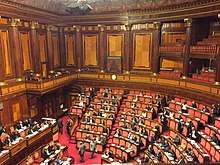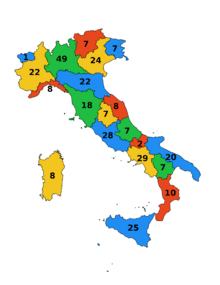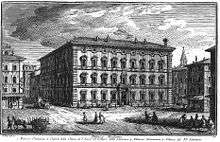Senate of the Republic (Italy)
The Senate of the Republic (Italian: Senato della Repubblica) or Senate (Italian: Senato) is a house of the bicameral Italian Parliament (the other being the Chamber of Deputies). The two houses together form a perfect bicameral system, meaning they perform identical functions, but do so separately. Pursuant to Articles 57, 58, and 59 of the Italian Constitution, the Senate has a variable number of members, of which 309 are elected from Italian constituencies, 6 from Italian citizens living abroad, and a small number (currently 6) are senators for life (senatori a vita), either appointed or ex officio. It was established in its current form on 8 May 1948, but previously existed during the Kingdom of Italy as Senato del Regno (Senate of the Kingdom), itself a continuation of the Senato Subalpino (Subalpine Senate) of Sardinia established on 8 May 1848. Members of the Senate are styled Senator or The Honourable Senator (Italian: Onorevole Senatore)[1] and they meet at Palazzo Madama, Rome.
Senate of the Republic Senato della Repubblica | |
|---|---|
| 18th legislature | |
 | |
| Type | |
| Type | of the Parliament of Italy |
| Leadership | |
President of the Senate | |
| Structure | |
| Seats | 315 elected senators + 6 senators for life |
 | |
Political groups | Government (155)
Supported by (19)[note 1]
Opposition (145) Vacancies (2)
|
| Elections | |
| Parallel voting: 116 FPTP seats, 193+6 PR seats with 3% electoral threshold (D'Hondt method) | |
Last election | 4 March 2018 |
Next election | No later than 2023 |
| Meeting place | |
 | |
| Palazzo Madama, Rome | |
| Website | |
| www | |
| Footnotes | |
| |
Italian Republic
|
|---|
 |
| This article is part of a series on the politics and government of Italy |
| Constitution |
|
| Foreign relations |
|
Related topics |
Composition

The Senate consists of 315 elected members, and as of 2018 six senators for life. The elected senators must be over 40 years of age and are elected by Italian citizens aged 25 or older.
The Senate (except for six senators who represent Italians residing abroad and the senators for life) is elected on a regional basis. The 309 senators are assigned to each region proportionally according to their population. However, Article 57 of the Constitution provides that no region can have fewer than seven senators representing it, except for the Aosta Valley (which has one) and Molise (which has two).
| Region | Seats | Region | Seats | Region | Seats |
|---|---|---|---|---|---|
| 7 | 7 | 8 | |||
| 1 | 28 | 25 | |||
| 20 | 8 | 7 | |||
| 7 | 49 | 18 | |||
| 10 | 8 | 7 | |||
| 29 | 2 | 24 | |||
| 22 | 22 | Overseas constituencies | 6 |
The senators for life are composed of former Presidents of the Italian Republic who hold office ex officio, and up to five citizens who are appointed by the President "for outstanding merits in the social, scientific, artistic or literary field". The current life senators are:[2]
| Senator for life | Appointment | Since | Parliamentary group |
|---|---|---|---|
| Giorgio Napolitano Politician, former President of the Republic |
Ex officio (Previously appointed by Carlo Azeglio Ciampi) |
14 January 2015 (ex officio) 23 September 2005 to 15 May 2006 (appointed) |
For the Autonomies |
| Mario Monti Economist, former Prime Minister |
Appointed by Giorgio Napolitano | 9 November 2011 | Mixed Group |
| Elena Cattaneo Professor of pharmacology |
Appointed by Giorgio Napolitano | 30 August 2013 | For the Autonomies |
| Renzo Piano Pritzker Prize-winning architect |
Appointed by Giorgio Napolitano | 30 August 2013 | None |
| Carlo Rubbia Nobel Prize-winning particle physicist and inventor |
Appointed by Giorgio Napolitano | 30 August 2013 | None |
| Liliana Segre Holocaust survivor |
Appointed by Sergio Mattarella | 19 January 2018 | Mixed Group |
The current term of the Senate is five years, except for senators for life that hold their office for their lifetime. Until a Constitutional change on February 9, 1963, the Senate was elected for six-year terms. The Senate may be dissolved before the expiration of its normal term by the President of the Republic (e.g. when no government can obtain a majority).
Electoral system and election of the Senate
According to article 58 of the Italian constitution, people aged more than 25 years are enabled to vote for the Senate.[3]
The electoral system is a parallel voting system, with 37% of seats allocated using first-past-the-post voting (FPTP) and 63% using proportional representation, allocated with the largest remainder method, with one round of voting.
- The 315 elected senators are elected in:
- 116 in single-member constituencies, by plurality;
- 193 in multi-member constituencies, by regional proportional representation;
- 6 in multi-member abroad constituencies, by constituency proportional representation.
For Italian residents, each house members are elected by single ballots, including the constituency candidate and his/her supporting party lists. In each single-member constituency the deputy/senator is elected on a plurality basis, while the seats in multi-member constituencies will be allocated nationally. In order to be calculated in single-member constituency results, parties need to obtain at least 1% of the national vote. In order to receive seats in multi-member constituencies, parties need to obtain at least 3% of the national vote. Elects from multi-member constituencies will come from closed lists. The single voting paper, containing both first-past-the-post candidates and the party lists, shows the names of the candidates to single-member constituencies and, in close conjunction with them, the symbols of the linked lists for the proportional part, each one with a list of the relative candidates.
The voter can cast their vote in three different ways:
- Drawing a sign on the symbol of a list: in this case the vote extends to the candidate in the single-member constituency which is supported by that list.
- Drawing a sign on the name of the candidate of the single-member constituency and another one on the symbol of one list that supports them: the result is the same as that described above; it is not allowed, under penalty of annulment, the panachage, so the voter can not vote simultaneously for a candidate in the FPTP constituency and for a list which is not linked to them.
- Drawing a sign only on the name of the candidate for the FPTP constituency, without indicating any list: in this case, the vote is valid for the candidate in the single-member constituency and also automatically extended to the list that supports them; if that candidate is however connected to several lists, the vote is divided proportionally between them, based on the votes that each one has obtained in that constituency.
A small, variable number of senators for life are also members of the Senate.
Reform proposal
In 2016, Italian Parliament passed a constitutional law that "effectively abolishes the Senate as an elected chamber and sharply restricts its ability to veto legislation".[4] The law was rejected on 4 December 2016 by a referendum, leaving the Senate unchanged.[5]
Membership
The current membership of the Senate of the Republic, following the latest political elections of 4 March 2018:
| Coalition | Party | Seats | % | ||
|---|---|---|---|---|---|
| Centre-right coalition | League (Lega) | 58 | 18.4 | ||
| Forza Italia (FI) | 58 | 18.4 | |||
| Brothers of Italy (FdI) | 16 | 5.1 | |||
| Us with Italy (NcI) | 5 | 1.6 | |||
| Total seats | 137 | 43.5 | |||
| Five Star Movement (M5S) | 112 | 35.5 | |||
| Centre-left coalition | Democratic Party (PD) | 53 | 16.8 | ||
| More Europe (+Eu) | 1 | 0.3 | |||
| Together (IEI) | 1 | 0.3 | |||
| Popular Civic List (CP) | 1 | 0.3 | |||
| SVP–PATT | 3 | 1.0 | |||
| Aosta Valley (VdA) | 1 | 0.3 | |||
| Total seats | 60 | 19.1 | |||
| Free and Equal (LeU) | 4 | 1.3 | |||
| Associative Movement Italians Abroad (MAIE) | 1 | 0.3 | |||
| South American Union Italian Emigrants (USEI) | 1 | 0.3 | |||
| Total | 315 | 100 | |||
Presidents
Under the current Constitution, the Senate must hold its first sitting no later than 20 days after a general election. That session, presided by the oldest senator, proceeds to elect the President of the Senate for the following parliamentary period. On the first two attempts at voting, an absolute majority of all senators is needed; if a third round is needed, a candidate can be elected by an absolute majority of the senators present and voting. If this third round fails to produce a winner, a final ballot is held between the two senators with the highest votes in the previous ballot. In the case of a tie, the elder senator is deemed the winner.
In addition to overseeing the business of the chamber, chairing and regulating debates, deciding whether motions and bills are admissible, representing the Senate, etc., the President of the Senate stands in for the President of the Republic when the latter is unable to perform the duties of the office; in this case the Senate is headed by a vice president.[6]
The current President of the Senate is Maria Elisabetta Alberti Casellati.
Recent Presidents of the Italian Senate:
| Name | Period | Legislature | |
|---|---|---|---|
| Ivanoe Bonomi (PSDI) | 8 May 1948 – 20 April 1951 | I | |
| Enrico De Nicola (PLI) | 28 April 1951 – 24 June 1952 | I | |
| Giuseppe Paratore (PLI) | 26 June 1952 – 24 March 1953 | I | |
| Meuccio Ruini (Independent) | 25 March 1953 – 25 June 1953 | I | |
| Cesare Merzagora (Independent) | 25 June 1953 – 7 November 1967 | II, III, IV | |
| Ennio Zelioli-Lanzini (DC) | 8 November 1967 – 4 June 1968 | IV | |
| Amintore Fanfani (DC) | 5 June 1968 – 26 June 1973 | V, VI | |
| Giovanni Spagnolli (DC) | 27 June 1973 – 4 July 1976 | VI | |
| Amintore Fanfani (DC) | 5 July 1976 – 1 December 1982 | VII, VIII | |
| Tommaso Morlino (DC) | 9 December 1982 – 6 May 1983 | VIII | |
| Vittorino Colombo (DC) | 12 May 1983 – 11 July 1983 | VIII | |
| Francesco Cossiga (DC) | 12 July 1983 – 24 June 1985 | IX | |
| Amintore Fanfani (DC) | 9 July 1985 – 17 April 1987 | IX | |
| Giovanni Malagodi (PLI) | 22 April 1987 – 1 July 1987 | IX | |
| Giovanni Spadolini (PRI) | 2 July 1987 – 16 April 1994 | X, XI | |
| Carlo Scognamiglio (FI) | 16 April 1994 – 9 May 1996 | XII | |
| Nicola Mancino (PPI) | 9 May 1996 – 30 May 2001 | XIII | |
| Marcello Pera (FI) | 30 May 2001 – 29 April 2006 | XIV | |
| Franco Marini (PD) | 29 April 2006 – 29 April 2008 | XV | |
| Renato Schifani (PdL) | 29 April 2008 – 16 March 2013 | XVI | |
| Pietro Grasso (PD) | 16 March 2013 – 23 March 2018 | XVII | |
| Maria Elisabetta Alberti Casellati (FI) | 24 March 2018 – incumbent | XVIII | |
Palazzo Madama


Since 1871, the Senate has met in Palazzo Madama in Rome, an old patrician palace completed in 1505 for the Medici family. The palace takes its name from Madama Margherita of Austria, daughter of Charles V and wife of Alessandro de' Medici. After the extinction of the Medici, the palace was handed over to the House of Lorraine. and, later, it was sold to Papal Government.
Later, in 1755, Pope Benedict XIV (whose coat of arms still dominates the main entrance) ordered major restructuring, entrusting the work to Luigi Hostini. In the following years there were installed the court offices and police headquarters. In 1849, Pius IX moved the Ministries of Finances and of the Public Debt here, as well as the Papal Post Offices. After the conquest of Rome by the newly formed Kingdom of Italy, the palace was chosen to become the seat of the Senato del Regno (Senate of the Kingdom).

Palazzo Madama and the adjacent buildings underwent further restructuring and adaptation in the first decades of the 20th century. A radical transformation which involved, among other things, the modernization of the hemicycle, the full remaking of the prospectus on Via San Salvatore and Via Dogana Vecchia, and the establishment of a connection with the adjacent Palazzo Carpegna. The latter, owned by the Senate, was entirely rebuilt in an advanced position compared to its original position. The small church of San Salvatore in Thermis, dating to the 6th century, which stood in the street to the left of the palace, was first closed, expropriated and later razed for security reasons.
The current façade was built in the mid-1650s by both Cigoli and Paolo Maruccelli. The latter added the ornate cornice and whimsical decorative urns on the roof. Among the rooms one of the most significant (and perhaps the most impressive from the political point of view) is the "Sala Maccari," which takes its name from Cesare Maccari, the artist who decorated it in 1880 and created the frescoes, among which stands out as one that depicts Cicero makes his indictment of Catiline, who listens, isolated from their seats.
The chamber where the Senate met for the first time on 27 November 1871 was designed by Luigi Gabet. A plaque on the wall behind the speaker's chair commemorates the king's address to Parliament when first convened in the new seat of government:
L'ITALIA È RESTITVITA A SE STESSA E A
ROMA • QVI E' DOVE NOI RICONOSCIAMO LA
PATRIA DEI NOSTRI PENSIERI; OGNI COSA
CI PARLA DI GRANDEZZA MA NEL TEMPO
STESSO OGNI COSA CI RICORDA I NOSTRI
DOVERI •
VITTORIO EMANVELE II
27 NOVEMBRE MDCCCLXXI
"Italy is restored to herself and to Rome... Here, where we recognise the fatherland of our thoughts, all things speak to us of greatness; but at the same time all things remind us of our duties..." - Victor Emmanuel II, 27 November 1871
Above this has been placed a plaque bearing the inscription:
IL 2 GIUGNO 1946
PER SUFFRAGIO DI POPOLO
A PRESIDIO DI PUBBLICHE LIBERTÀ
E A CERTEZZA DI PROGRESSO CIVILE
FU PROCLAMATA
LA REPUBBLICA ITALIANA
On 2 June 1946
by popular suffrage
in defence of public liberty
and a certainty of civic progress
was proclaimed
the Italian Republic
To the viewers' left stand the flags of the Italian Republic (with a ribbon embroidered with the words SENATO DELLA REPUBBLICA) and the European Union.
See also
- Parliament of Italy
- Italian Chamber of Deputies
- Senate
- Roman Senate
- Senato Italiano (TV channel)
- List of Senators for life in Italy
Notes
- Senators for life Giorgio Napolitano and Renzo Piano have never taken their seats in the current legislature, therefore the government is de facto supported by 17 senators.
References
- "onorevole [o-no-ré-vo-le] agg., s." Corriere della Sera. Dizionario di Italiano (in Italian). Retrieved 15 June 2020.
- "Senatori a vita, XVIII Legislatura (dal 23 marzo 2018)" [Senators for life, 18th Legislature (since 23 March 2018)]. Senato.it (in Italian). Retrieved 15 June 2020.
- "Constitute". Constituteproject.org. Retrieved 15 June 2020.
- "Italy passes Renzi's flagship reform, opening way for referendum". Reuters. 12 April 2016. Retrieved 15 June 2020.
- "Referendum costituzionale 2016: vince il No. I pro e contro della riforma" [Constitutional referendum 2016: "No" wins. The pros and cons of the reform]. Money.it (in Italian). 5 December 2016. Retrieved 15 June 2020.
- Giampiero Buonomo, Marco Cosentino (1999). "Il Vicario del Presidente nelle Assemblee parlamentari con particolare riferimento al Senato della Repubblica italiana" [The Vicar of the President in the Parliamentary Assemblies with particular reference to the Senate of the Italian Republic]. Academia.edu (in Italian). p. 24-37. Retrieved 15 June 2020.
External links
| Wikimedia Commons has media related to Senate of the Republic (Italy). |
- Official website (in Italian)
- Official website (in English)